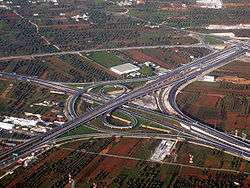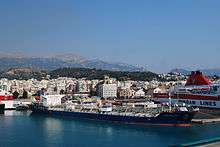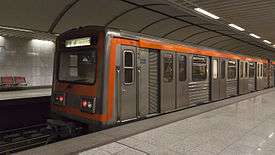Transport in Greece
| Economy of Greece |
|---|
 |
| Overview |
| History |
| Related |
|

Transport in Greece have undergone significant changes in the past two decades, vastly modernizing the country's infrastructure and transportation. Although ferry transport between islands remains the prominent method of transport between the nation's islands, improvements to the road infrastructure, rail, urban transport, and airports have all led to a vast improvement in transportation. These upgrades have played a key role in supporting Greece's economy, which in the past decade has come to rely heavily on the construction industry.
Rail transport
Railways
- total: 2,571 km (764 km are (or will be) electrified)
- standard gauge: 1,565 km 1.435-m gauge
- narrow gauge: 961 km 1.000-m gauge; 22 km 0.750-m gauge
- dual gauge: 23 km combined 1.435 m and 1.000-m gauges (three rail system) (2004)
The state owned company that owns and maintains Greece's railway network is called OSE, while TrainOSE is the company responsible for operating all passenger and freight trains.
Metro
Cities with a rapid transit railway network:
- Athens - Athens Metro (3 lines)
- Thessaloniki - Thessaloniki Metro (2 lines) (under construction)
Commuter Rail

Cities with a commuter rail network (Proastiakos):
- Athens (4 lines)
- Thessaloniki (2 lines)
- Patras (1 line)
Tram
Road transport
Highways


- As of 2017, Greece has 2500 km of motorways.
Roads:
- total: 117,000 km
- paved: 107,406 km
- unpaved: 9,594 km (1996 est.)
- over 2500 underground tunnels (est.)
Bus transport
Urban bus transport
Intercity and regional bus transport
KTEL is the common name for every company which is responsible for intercity and regional bus transit. Most of the regional units, though, have their own regional network of buses, and have their regional unit names labeled on KTEL vehicles that operate there. (e.g. KTEL Argolidas).
Water transport
Waterways

The 80 km system consists of three coastal canals including the Corinth Canal (6 km) and three unconnected rivers.
The Corinth Canal crosses the Isthmus of Corinth, connecting the Gulf of Corinth with the Saronic Gulf; and shortens the sea voyage from the Adriatic to Piraeus by 325 km.
Ports and harbours
Merchant Marine
- total: 3338 ships (with a volume of 1,000 gross register tons (GRT) or over) totaling 109,377,819 GRT/182,540,868 tonnes deadweight (DWT)
- ships by type (1999 est.)
- bulk carrier: 273
- cargo ship: 60
- chemical tanker: 22
- combination bulk: 5
- combination ore/oil: 8
- container ship: 43
- Liquified Gas Carrier: 5
- multi-functional large load carrier: 1
- passenger ship: 12
- passenger/cargo: 2
- petroleum tanker: 245
- refrigerated cargo: 3
- roll-on/roll-off ship: 19
- short-sea passenger: 75
- specialized tanker: 4
- vehicle carrier: 2
Airports
- total: 82 (2005)
- With paved runways: 67
- over 3,047 m: 5
- 2,438 to 3,047 m: 16
- 1,524 to 2,437 m: 19
- 914 to 1,523 m: 17
under 914 m: 10 (2005)
- With unpaved runways: 15
- 914 to 1,523 m: 3
- under 914 m: 12 (2005)
- heliports: 8 (2005)
Pipelines
- crude oil: 26 km
- petroleum products: 547 km
Major Construction Projects
Completed Projects
Motorways
- Egnatia Odos 670 km (420 mi)
- Motorway 25
- Motorway 29 77 km (48 mi)
- Ionia Odos "196 km (122 mi)"
- Motorway 1 (PATHE) 550 km (340 mi)
- Attiki Odos 69.7 km (43.3 mi)
- Moreas Motorway 205 km (127 mi)
- Olympia Odos 210 km (130 mi)
- Rio–Antirrio bridge 2,880 metre long (9,449 ft) (2nd longest cable bridge in Europe
Railways
Airports
Projects under construction
Motorways
- Central Greece Motorway
- North Road Axis of Crete
- Branches of Egnatia Odos
Railways
- electrification and building double track on sections of Piraeus–Platy railway
- Line 3 (Athens Metro) extension to Piraeus
- Line 4 (Athens Metro)
- Thessaloniki Metro
- Athens Tram extension to Piraeus
Future projects
Motorways
- Larisa-Kozane Motorway
Railways
- Kiato-Patras standard gauge railway
- Line 4 (Athens Metro)
- Igoumenitsa-Ioannina-Kalampaka Railway line
- Kalampaka-Kastoria Railway line
- Florina-Pogradec Railway line
- Kalampaka-Kozani-Thessaloniki-Kavala-Toxotes Railway line
- Ioannina-Rio Railway line
- Thessaloniki-Chalkidiki Railway line
- Thessaloniki-Giannitsa-Skydra Railway line
- Chania-Rethymnon-Herakleion Railway line
- Thessaloniki Tram
- Patras Tram
- Larisa Tram
- Ioannina Tram
- Volos Tram
Airports
See also
References

